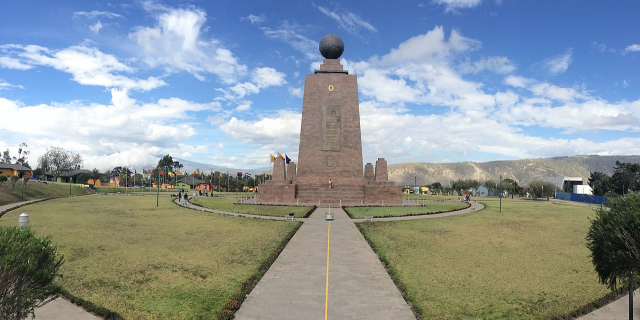The Sanctuary of Las Lajas (in full Sanctuary of Our Lady of the Holy Rosary of Las Lajas) is a Roman Catholic minor basilica located within the canyon of the Guáitara River in Ipiales, Nariño Department, Colombia. The Marian shrine is dedicated to the Blessed Virgin Mary as Our Lady of the Rosary.
Pious believers claim that the colorful Madonna and Child image displayed on the rock wall is of divine origin, and that it was formed without human intervention. The current church was built in a neo-gothic architectural style between 1916 and 1949. The name Laja is Spanish for a flagstone, and comes from the name of a type of flat sedimentary rock.
Pope Pius XII granted a Pontifical Decree of coronation to the image as Sancta Virgo de Rupe (English: Holy Virgin of the Rock) on 31 May 1951. He also raised the Marian shrine to the status of a Minor basilica via his decree Templum per Decorum on 30 August 1954. Pope Paul VI granted the Mari...Read more
The Sanctuary of Las Lajas (in full Sanctuary of Our Lady of the Holy Rosary of Las Lajas) is a Roman Catholic minor basilica located within the canyon of the Guáitara River in Ipiales, Nariño Department, Colombia. The Marian shrine is dedicated to the Blessed Virgin Mary as Our Lady of the Rosary.
Pious believers claim that the colorful Madonna and Child image displayed on the rock wall is of divine origin, and that it was formed without human intervention. The current church was built in a neo-gothic architectural style between 1916 and 1949. The name Laja is Spanish for a flagstone, and comes from the name of a type of flat sedimentary rock.
Pope Pius XII granted a Pontifical Decree of coronation to the image as Sancta Virgo de Rupe (English: Holy Virgin of the Rock) on 31 May 1951. He also raised the Marian shrine to the status of a Minor basilica via his decree Templum per Decorum on 30 August 1954. Pope Paul VI granted the Marian title as the Virgin of the Holy Rosary as the Patroness of Ipiales via his decree Tutela Cælestis Virtutis on 26 April 1965.
It is a popular pilgrimage site for Christians from both Colombia and neighboring Ecuador, due to a Marian apparition that is purported to have taken place here in the 18th century.
The inspiration for the church's creation was a purported miraculous event in 1576 (maybe), when amerindian Maria Meneses de Quiñones and her deaf-mute daughter Rosa were caught in a very strong storm. The two sought refuge between the small Lajas (slabs of stone), when, to Meneses' surprise, her daughter Rosa exclaimed "the Mestiza is calling me" and pointed to a lightning-illuminated silhouette over the laja. This apparition of the Virgin Mary instigated popular pilgrimage to the site and occasional reports of cases of miraculous healing. An image appeared in the stone that is several feet inside of it. The image in the stone is still visible today.[1]
The existence of a shrine in this location was recorded in the accounts of friar Juan de Santa Gertrudis' journey through the southern region of the New Kingdom of Granada between 1756 and 1764. The first shrine was built here in the middle of 18th century from straw and wood. It was replaced with a 7 meter long brick chapel in 1795/96. From 1802 on, a new, larger shrine was built, which in turn was extended and connected to the opposite side of canyon with a bridge in the second half of the 19th century.
The current church was built between January 1, 1916, and August 20, 1949, with donations from local churchgoers. It rises 100 m (330 ft) high from the bottom of the canyon and is connected to the opposite side of the canyon by a 50 m (160 ft) tall bridge.[2]
DedicationThe shrine is located in southern Colombia and has been a tourism and pilgrimage destination since the eighteenth century. The Spanish Franciscan Juan de Santa Gertrudis (1724–1799) mentions the sanctuary in Book III, Part 2, of his four-volume chronicle of his 1756–62 journey in the south portion of the Kingdom of New Granada (titled "Wonders of Nature"). This is possibly the oldest reference to its existence.

































Add new comment